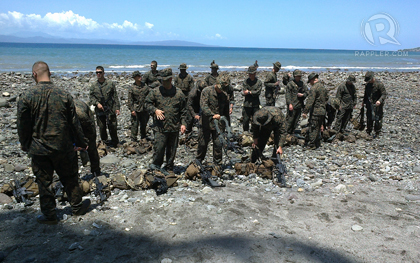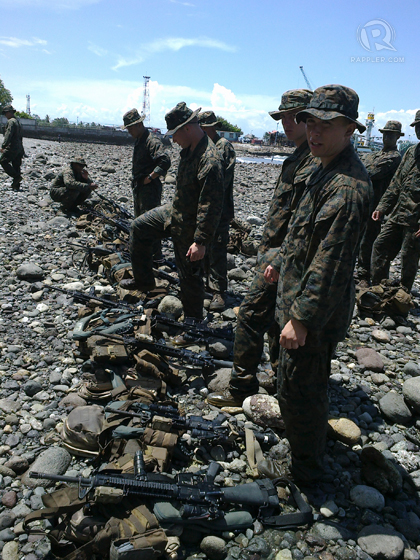SUMMARY
This is AI generated summarization, which may have errors. For context, always refer to the full article.

GENERAL SANTOS CITY, Philippines – “Iyan ang pangarap natin. Magkaroon man lang sana tayo niyan.” (That is our dream. We wish we’d own one like that.)
Navy Commander Lued Lincuna said this with a sense of resignation as his patrol boat approached USS Vandegrift past noon Sunday, July 1, at the mouth of Sarangani Bay, some 20 nautical miles off General Santos City.
The US frigate is not even in the list of the US Navy’s top-of-the-line warships. “Over 25 nautical miles (per hour),” was all Commodore David Welch would volunteer to say when we asked about its maximum speed.
Welch is Task Group 73.1 commander of the US Navy that is participating in the ongoing 2012 CARAT exercises in this city. CARAT stands for Cooperation Afloat Readiness and Training, an 18-year joint military exercise and training between the US and its allies in Southeast Asia.
USS Vandegrift is a versatile vessel capable of navigating international waters and behind hostile territories. It’s armed with torpedoes and is also designed for anti-submarine warfare. It can stay afloat for weeks on end without refueling. Most of all, it can eavesdrop anywhere in the world with its sophisticated listening and surveillance devices. Stationed in San Diego, California, it can be deployed anywhere in the world at a moment’s notice.
Docked side by side at Makar Wharf with USS Vandegrift is the US Coast Guard cutter USCGC Waesche. Commissioned in 2006, USS Waesche is the flagship of the US Coast Guard and its most modern vessel.
(Members of the local press here were only allowed limited tour on USS Vandergrift, commissioned in 1984, and were not brought to USCGC Waesche.)
Lincuna recalled the time when the Philippine Navy was known as one of the best in Asia.
“The Philippine Navy had its glory days in [the late 1960s and] 1970s (before Martial was declared),” Lincuna said as his fast attack craft BRP Salvador Abcede made a traditional welcome pass around Vandegrift.

The Philippine Navy however has deteriorated over the years.
According to global intelligence, “Philippine warships are armed entirely with mounted machine guns and deck guns, the largest of which is 3″ (76mm)…The Fleet lacks missile-armed ships, greatly limiting range and effectiveness against enemy warships and aircraft. Even antisubmarine (ASW) weapons like depth charges are absent on all or almost all of the Philippine warships. The Philippine Fleet also lacks its own submarines, not to mention aircraft carriers.”
The Philippine Navy was supposed to be the major beneficiary of the P331-billion (US$ 8 billion) 15-year modernization program of the Armed Forces of the Philippines that was crafted in 1995. The program never took off until recently when the Navy acquired BRP Gregorio del Pilar, and before that BRP Ramon Alcaraz, under the Excess Defense Articles and the 1961 Foreign Assistance Act of US government.
In May this year, the Philippine Navy issued its own wish list for the modernization of its fleet. It includes 6 frigates configured for anti-air warfare, 12 corvettes designed for anti-submarine warfare, 18 Offshore Patrol Vessels (OVs), 3 submarines, 3 Mine Counter Measure Vessels (MCMVs), 4 Strategic Sealift Vessels (SSVs), 18 Landing Craft Utility (LCU) among others.

The Navy’s biggest ship right now is the refurbished BRP Gregorio del Pilar.
BRP Gregorio del Pilar was formerly USCGC Hamilton (WHEC-715), built in 1965 but decommissioned by the US Coast Guard in the same year it was transferred to the Philippine Navy.
Commodore Philip Cacayan, commander of the Philippine Navy’s Naval Forces Eastern Mindanao command, said what the navy lacked in equipment and armaments, they make up with their resilience.
He is confident that the Philippine Navy would eventually catch up with its neighbors in Southeast Asia.
Even its ground forces – the Philippine Marines – are still equipped with Vietnam War-era M-16 riffles.

Side by side with some 50 US Marine troops during a riverine exercise, the Philippine Marines and Philippine coast guards can only wish they will someday be issued the M4 version of the Armalite rifles that is currently the standard issue in the US military.
From the combat boots to caps and uniforms to the minutest of combat gear, the Filipino soldier is his US counterpart’s poor cousin.
And each time these exercises are held, the Philippine Navy is reminded that it has a long way to go before it can call its forces a naval fleet. – Rappler.com
Related stories:
Elsewhere in Rappler:
Add a comment
How does this make you feel?
There are no comments yet. Add your comment to start the conversation.